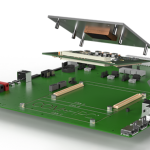The train and railways markets are thriving, involving many new technologies, for on-board connectivity, comfort and infotainment systems on the passenger side, and connectivity and AI for maintenance, reliability and safety on the operations side.
Here, analysts from Future Market Insights (FMI) market research, present three key areas of development of these types of systems.
- Railway systems
The railway system market is estimated to be worth $45.1bn between year 2023 and 2033, growing at a compound annual rate (CAGR) of 4.8%. Currently the market is valued at just over $28bn.
Surging urbanisation worldwide and the growing number of vehicles on the roads are adding to bad traffic congestions, which in turn is leading many to seek public modes of transport, such as trains, metro rails, and so on, to move around cities. Rail operators are responding by improving the comfort, infotaintment, connectivity and functionalities offered onboard their trains, which increases the demand for railways systems. High-speed rail technology advancements such as magnetic levitation and Hyperloop, as well as hydrogen fuel-cell technology for zero emissions, will drive global market growth going forward.
Furthermore, government authorities worldwide are investing tremendous amounts in upgrading their countries’ railway infrastructure. Moreover, using railways stands in line with the adoption of renewable sources of energy; many economies are laying the foundations for ‘Green Transportation’, which will lead to even greater adoption of railways.
The railways’ green status is further underpinned by their limited use of fuel, which is a lot lower than that of airlines, for example, and the load capacity of the railways is also much higher.
The railway system market is expected to see a form of renaissance with the application of the Internet of Trains, making this mode of transport more reliable, safer and easier to maintain. The Internet of Trains will be underpinned by AI, which is expected to revolutionise this market. Increasing investment in analytics systems by network operators in developed nations, as well as improvements aimed at enhancing customer experience, are important driving factors for the growth of the global industry.
Smart technologies such as advanced train control systems, advanced passenger information systems, and real-time location information for each railway carriage, to monitored for schedule compliance and navigation of the moving train. It is predicted that providing precise real-time information on the status and location of in-transit railcars will boost passenger satisfaction. All these improvements has attracted the interest of many technology companies worldwide. In February 2022, The CRRC developed 3000hp permanent magnet hybrid shunting locomotive just completed 2,000 kilometers of safe operation. Consumers praised the locomotive for its extraordinarily low energy consumption and environmental protection when compared to a traditional shunting diesel locomotive.
In May 2022, Hitachi Rail introduced many new automation and digitalisation advancements, including PTC (Positive Train Control), railcar telematics and dispatching systems.
In January 2022, Siemens created the new air-free brake system, also known as an electronic friction brake system, which is the first completely electronically controlled friction brake to be deployed in rail vehicles (brake-by-wire). The braking system operates without the need for compressed air. In addition to several technological advantages, the new brake reduces vehicle weight and increases vehicle speed.
In December 2021, Alstom, in collaboration with Cylus, deployed an advanced rail cybersecurity solution on the Tel Aviv Red Line to increase the protection of the line’s signalling and train control systems. CylusOne is a multi-layered rail-specific cybersecurity solution powered by sophisticated Al and ML technologies.
Based on regional analysis, North America will see the largest market growth during the forecast period; at present that market share is 21.8%. In comparison, Germany’s market share is only 4.4%, Japan’s 5.7% and Australian’s 1.3%. China’s market is expected to grow at a CAGR of 5.7% for that same period, India’s at a 7.1%. rate, and the UK’s at a CAGR of 4.1%.
Based on applications, passenger transportation currently has the largest market share at 64.8%. In this space manufacturers are making important steps to work toward sustainability goals.
- Railway telematics systems
The market for railways telematics systems is expected to reach $13bn by 2033. In 2023 it was valued at $6bn, to grow at a CAGR of 7.1% to year 2033.
Quick asset deployment, use and maintenance of railcars has increased the adoption of railways telematics globally, buoying up all the business sectors providing these type solutions and services. Also, new technologies have become a necessity to make the freight and logistics sector better performing and more effective. The adoption of railway telematics, including monitoring of refrigeration wagons and forecasted arrival times for every other railcar, is the key factor driving the market in present.
According to our recent market report, the US holds a share of nearly 18.5% of the global railway telematics market. Owing to the presence of many leading OEMs in the US, the overall revenue generated there in 2023 is about $1.2bn.
In Europe, Germany is the largest regional market for railway telematics, and offers plenty of room for further expansion. The country accounts for some 4.7% of the money made by providing railway telematics services globally.
Close second in Europe for adopting railway telematics technologies for freight management is the UK, which is likely to see a further growth of 3.3% annually to 2033.
China is the leading market among the Asia Pacific countries in terms of the production of railway telematics components and services. This country will experience a higher CAGR, 4.3%, from 2023 to 2033.
Japan is another significant contributor to the Asia Pacific railway telematics market, with a share of 5.2% of the global market. With advanced component manufacturers as well as excellent service providers, this country is estimated to generate revenues of nearly $350m in 2023.
We see India as the world’s fastest-growing market for railway telematics for the time being. Through to 2033, the region is expected to grow at a pace of 5.4% thanks to domestic railway infrastructure expansion projects and improved export capabilities.
Australia has garnered enough traction in the global railway telematics business recently, having a strong export potential for South-East Asian countries and other nations. This country has a sizable train transit system, accounting for some 2.3% of the overall worldwide income.
In the railways telematics systems, from 2023 to 2033, the component segment of sensors is expected to grow at a higher rate than any other. This is also a major contributing segment that holds a share of some 45.5% of the overall market.
In this space we see giants such as Siemens, Alstom, Knorr-Bremse, Robert Bosch, Hitachi, Intermodal Telematics, Intrex Telematics, ORBCOMM, Rail nova, Savvy Telematics, and Trinity Industries compete.
- Railway interior lighting systems
The railway interior lighting market is expected to be worth $263m in 2023, growing to $364m by 2033, at a CAGR of 3.3%.
The growing population in metropolitan centres, increased urbanisation and growing government involvement in creating public transportation infrastructure such as metro trains, high-speed trains, but also restored trains, are the main contributing factors here, and the demand for LEDs and supporting technologies remains high.
Geographically, North America is the key region that dominates the market with a share of 17.9%.
By Future Market Insights market analysts










